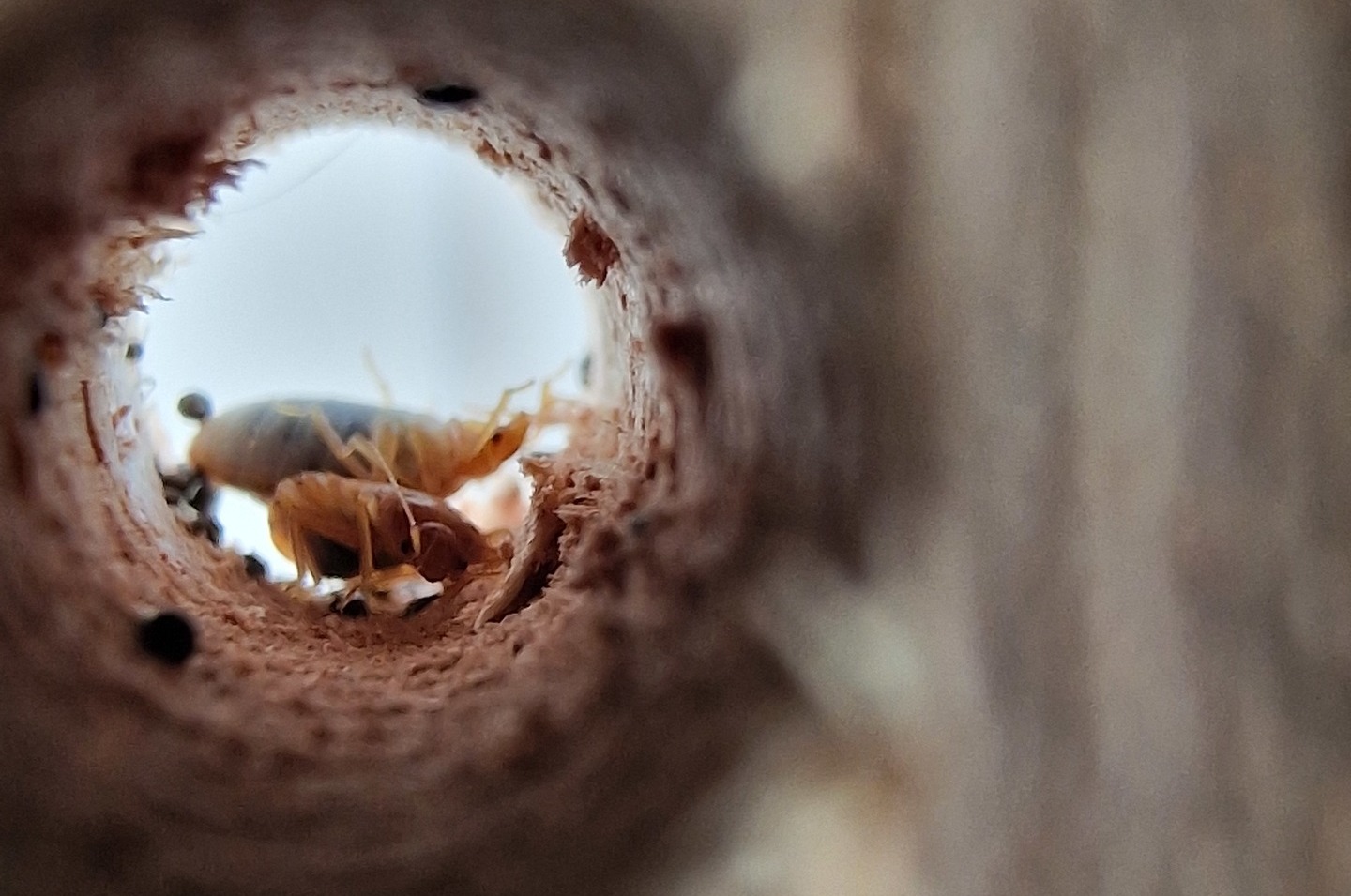Bedbugs are in the news, but is it really news?
Posted on 19th October 2023 at 13:53
Bedbugs are all over the news at the moment, but are they news?

Bedbugs are making headline news now because of the situation in Paris, it seems that the French have got themselves into a bit of bother and the capital is bursting at the seams with them. To make matters worse, it’s now alleged that they’ve boarded the Eurostar and are heading here right now! Well, that’s not really news, it’s just a handful of facts, a sprinkling of hysteria and a smidge of anticipation all wrapped up together to form a headline grabbing piece of clickbait and a way for some pest control companies to rachet up their prices for bedbug treatments.
Why do I say this when everyone else is predicting that the sky is about to fall down? Because, sadly its true, this is nothing but sensationalism and something that we in the pest control industry do time and time again to sell our services at a premium price. Ok if you’re in any doubt, ask yourself this question, how would you make pest control … sexy?
Pest control is not exactly an industry that’s synonymous with excitement or thrills, there’s no ooh, arrhhh factor, we’re not topflight footballers or superstar band members but there’s one thing we can do very well which they can’t. We have the ability to put the fear of God into you, yeah, that’s our “superpower” and we do this by writing articles and banging on about the latest pest and how it’s already inside your home. Whether its mutant rats that are resistant to any poison known to man, and these can grow to the size of cats, or invasive killer hornets that will ruin any picnic and then of course, our special little friends … bedbugs.

The horror of bedbugs

Whenever you read one of these articles in one of the redtops or you hear a ‘so called’ expert on local radio, usually its Mr X from a pest control company with KILL in the title, they’ll tell you all these horror stories about the latest faddy pest, whether it’s about rats or bed bugs it really doesn’t matter and you’ll notice one thing about these stories, a complete lack of facts to back them up. There will never be any facts to support the evidence, which is so important that its all over the news; there’s no data to collaborate the stories being told, they’re just that, nothing more than tall tales.
Anyone who’s been in the pest control industry for any length of time will have an absolute library of horror stories from which they can draw on and then weave stories that would make your hair stand on end, I know because I do it all the time. As I said earlier, it’s not a really sexy job but I get to go places and into situations that would be beyond your imagination – almost every day!
With pests, some species give you an almost defined season, for example, you’d expect to be treating wasps in the summer and autumn and not in the winter so summer is when the killer hornet stories appear. When it comes to bedbugs when would you expect their season to be? Peak season is now, right now and I am busy with them, but no busier than normal, the reason for this is everyone is now back from their holidays.

Bedbugs are natures expert hitchikers

In 2022 we made 45 and a half million overseas trips for holidays, in addition to that, the overseas visitors coming in ran at a figure of a hefty 19 million, so when you think about the total UK population being around 66 million people, it’s like a mad game of musical chairs. The shift in and then out again across the country will exceed the total amount of people that live here, so, if only a really small percentage of people bring back unwanted holiday souvenirs, you can see how bedbugs can become headline news. Or put it another way, if 1% of all tourists pick up bedbugs on their travels, we’d see upwards of 600,000 infestations, and that’s not news just statistics.
Have you ever thought what the word ‘news’ means? As a definition its information or reports about recent events, so I have to question why there’s so much coverage of bedbugs right now, when this is the time of year when you’d expect to be busy with them.
So what are the actual facts about bedbugs?
We have had problems with these insects since our early ancestors starting using caves, because this is where bat bugs discovered another hairy mammal species that they could feed from, and that was us. Despite being called bedbugs, they can, and unfortunately do, live in other places where we can spend long periods of time. Places like theatres, airplanes, trains, and buses can all host their own colonies of bedbugs that will hitchhike on unsuspecting carriers. Inside a domestic setting the two places that I usually find bedbugs will be beds (obviously) and in sofas.

How do I know if I've got bedbugs?

How do I know if we have bed bugs?
Bedbugs are not invisible but, and this is the but part, the problem with them is that they like to hide away in cracks and crevices deep inside the frame of beds where they can be extremely difficult to find. What usually happens is that my customers report getting bitten several weeks after being on holiday and having not seen any insects, they naturally assume the cause is mosquitoes and its only after a period of time when the bedbugs are multiplying that they become aware of the true nature of the problem.
Bedbugs love to squeeze into a tiny space where they’re pressed in and all sides and when you realise that their body thickness, is around the same as a single sheet of paper, these gaps are going to be incredibly small and difficult to examine.
If you suspect that you have a bed bug infestation, the best two signs to look for are – bloodspots and skin casings. Bedbugs feed on blood, and because they only want the solid bits inside of the liquid that makes up our blood, they will immediately excrete the liquid part and then feed again. Where they have crossed bedding or clothing to find the junction with uncovered skin, you will sometimes see lines of bites all from the bedbugs’ feeding session.
You may also see blood spots on bedding, and you’ll might notice them around their hiding places so look for black staining along seams and around wooden joints, a quick test to see if it’s a blood spot or not, is to lick your finger and run it over the area, if the spot smears then its dried blood and you definitely have bedbugs.
Discarded skins will be found because bed bugs grow as they age and they need to shed their outer skin in order to do this, so you may find their small, discarded skins which will be a light orangy-brown in colour. Generally, these just drop off and so gravity means they’ll be on the floor under the bed and along the top of horizontal surfaces such as supports under the mattress.

What do I do if I discover a bedbug?

What do I do if I discover a bedbug?
There is one thing that you must do if you do find bed bugs, and that is not to panic! Bedbugs are relatively benign despite the idea of them, they don’t transmit disease which can’t be said for the mosquitoes which everyone seems to be happy to have. Bedbugs naturally raise anxiety and are a cause of stress, the very thought of something feeding on you while your asleep is difficult to deal with and I’m not undermining that; I once had to sleep in a hotel bed, albeit for just one night with bedbugs and I know how distressing that was. But I can’t help but feel that at the moment, the fear is being ramped up out of all proportion by the media … and that’s because fear sells.
Bedbugs are easy to treat, especially in the early stages of an infestation, if left untreated they will become much harder to eradicate, and that’s largely down to their reproductive behaviour. The female bedbug doesn’t have a sexual opening, so in order to counter this, the male bed bugs’ penis is spear shaped and they punch it straight through the females’ abdominal wall, this is called traumatic insemination and the reason why bedbugs become harder to treat.
Because nature always finds a way, to get round this traumatic insemination, the male bedbug releases a highly attractive pheromone to lure the females back to their hiding places, and as with all creatures, there is competition to breed. This means that the males move away from each other by just a few inches and so you’ll see small clusters of bedbugs running along seams and where wooden joints are. After a period of time these groupings move from the bed into the surrounding furniture, and they gradually fill up all the available space around the bed. Slowly they will colonise the entire room, moving into wardrobes, behind pictures, up underneath the wallpaper and into places like electrical sockets.

Don't believe everything written about bedbugs

Now it’s time for a horror story, I told you we all have them, I once went to a house that had so many bedbugs that they’d left the bedroom, crossed the hallway and had taken up residence in the bathroom. On the ceiling around the light bulb mount you could see bedbugs peeking out, just waiting for their meal to come and use the toilet. In the lounge if you took a CD case out of the rack and opened it, yes you guessed it, they’d be bedbugs inside.
This was a really extreme case and I’ve only seen two infestations that heavy in over ten years of working across Berkshire. So, if you catch these insects early enough it shouldn’t be that difficult to treat, the information being pumped out across the media on having to wash all your clothes and remove all the items from bedrooms is pure over load and all part of “project fear”, all just designed to sell newspapers and bedbug treatments.
Bedbugs are in the news at the moment but they aren’t really new, Lewis Hamilton is a multi-millionaire racing car driver, he’s able to scare you with his fashion sense but as a pest controller, I could leave you awake at night, listening for scurrying sounds in the loft or scratching at imaginary bites, just don’t believe everything you read or hear, this is just bedbug season that’s all.

Tagged as: Bed bugs
Share this post:





